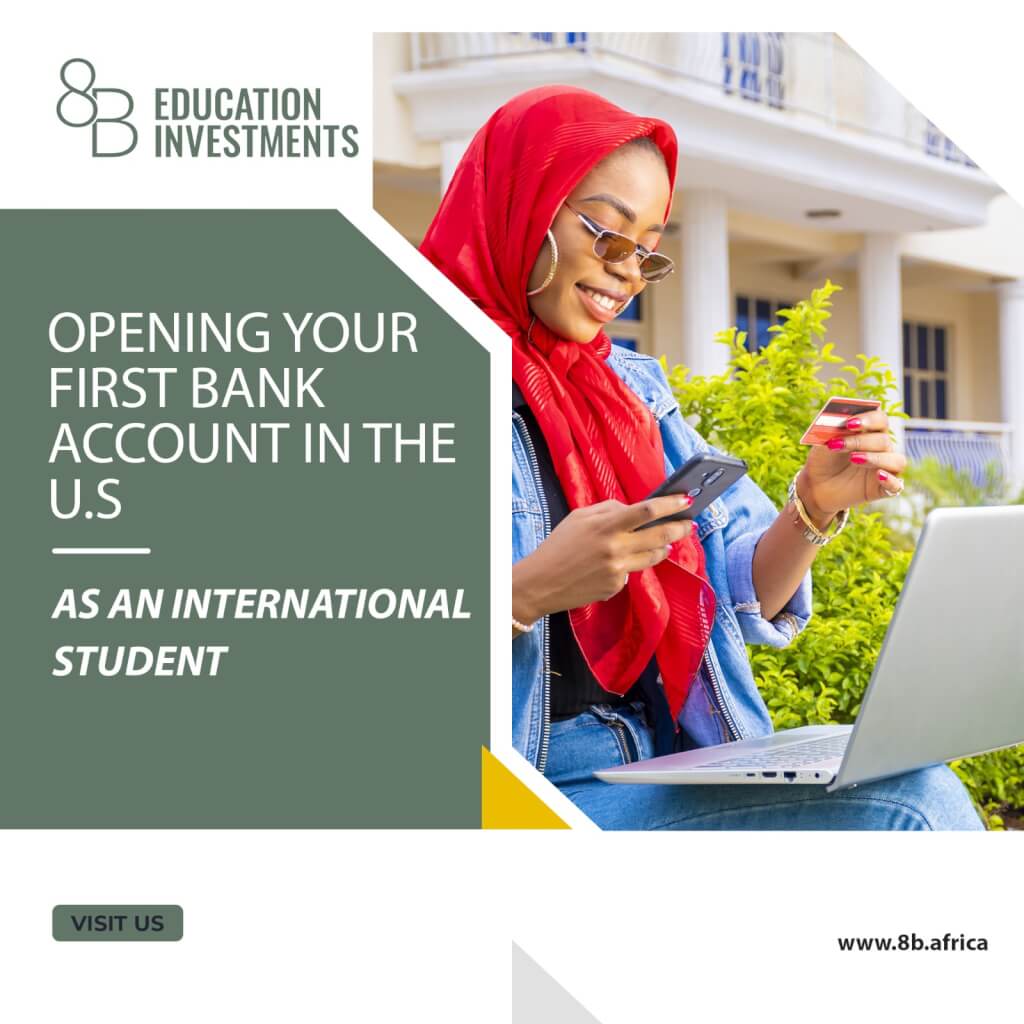When you arrive in the US for your studies, one of the first things on your to-do list should be opening your first bank account in the US.
“Can I use my home country’s bank account while studying in the U.S?”
While you may be able to use your home country’s bank account in the U.S, it’s not always practical or advisable. Converting your home country’s currency to dollars can be costly, you’ll incur additional transaction fees, and you’re likely to have limited access to ATMs and other banking services.
A U.S bank account, on the other hand, enables you to:
- Receive funds: If you receive financial aid or scholarships from your school, it’s likely that the funds will be deposited directly into a U.S bank account.
- Manage expenses: Having a U.S bank account makes it easier to manage day-to-day expenses, such as paying for rent, utilities, groceries, and other bills.
- Build credit history: Do you plan to stay in the U.S after graduation? Then it’s a good idea to start building your credit history – for which you need to have a U.S bank account. Having a good credit history in the U.S will help you when applying for loans, credit cards, or renting an apartment.
- Access banking services: With a U.S bank account, you’ll have access to ATMS and other banking services – such as free or low-cost wire transfers to and from your home country.
- Make online purchases: Many online merchants in the U.S require a U.S bank account or credit card to make purchases. Having a U.S bank account can be helpful in this regard.
In the section below, we outline the steps you need to take to open your first U.S bank account:
Step #1- Find the Right Bank
Don’t go for the first bank that shows up on your Google search results. Instead, find a few suitable options and compare them on these factors:
- Accessibility: Look for a bank with branches and ATMs located conveniently near your school and housing. You want to ensure that you can access funds easily.
- Fees: Compare the fees charged by different banks. Look at the monthly maintenance fees, overdraft fees, ATM fees, and foreign transaction fees. Choose the bank that offers low or no fees on the services you’re most likely to use.
- Account requirements: Some banks may require a minimum balance or a certain number of transactions each month to avoid fees. Make sure you understand the account requirements before opening an account, and choose one that’s feasible for your financial situation.
- Services for international students: Look for a bank that offers services specifically designed for international students. Such services may include free or low-cost wire transfers to and from your home country or assistance with establishing credit history in the U.S.
- Reputation: Don’t forget to do your homework on the bank’s reputation. Look up customer reviews to ensure that it’s a reputable and reliable institution.
- Online banking services: Check if the bank offers online banking services, as this can be a convenient way to manage your account, transfer funds, and pay bills.
- Customer service: Look for a bank with good customer service, including easy-to-reach customer support and helpful online resources. Choose a bank that is responsive to your needs and can help you resolve any issues that arise.
Step #2- Choose the Right Account
When opening a bank account as an international student in the U.S, you’ll have two main types of accounts to choose from: checking and savings.
Savings accounts are designed for earning interest on your deposits, rather than for making frequent transactions. If you have only a few bills to pay and want to keep your money safe, a savings account may be a good option for you.
On the other hand, checking accounts offer more flexibility when it comes to accessing your funds. With a checking account, you can withdraw money from ATMs and make payments with your debit card, similar to how a credit card works.
A checking account also allows you to set up direct deposits where your paycheck is automatically deposited into your account. In addition, you can use autopay to ensure your bills are paid on time each month.
Different banks may have different requirements and limitations for both types of accounts. For example, some banks may require a minimum monthly balance to avoid fees, while others may charge fees regardless.
With checking accounts, you may be able to avoid fees if you have direct deposit, but not every account holder will have this option available. Be sure to compare account options and carefully review any fees or limitations before choosing a bank and account type.
Step #3- Gather Required Documents
When opening a bank account as an international student in the U.S, you’ll need to gather certain documents to verify your identity and eligibility.
Here are the most commonly required documents:
- A valid passport as proof of your identity
- A copy of your student visa, which shows that you’re legally allowed to study in the U.S
- I-20 form if you’re an F-1 or M-1 visa holder to confirm your enrollment and eligibility to study in the U.S
- Social Security Number (SSN) to verify your identity and to report any interest earned on your account to the IRS
- Proof of your U.S home address – such as a lease agreement or utility bill
- Funding source documentation – such as a scholarship award letter or bank statement from your home country
Once you’ve selected a bank, check the specific documents they require for international students to open an account.
Gather all the necessary documents in advance to make the account opening process as smooth as possible.
Step #4- Open Your Bank Account
Once you have gathered all the required documents and have the minimum deposit required, you can begin the account opening process.
Some banks operate solely online, and in this case, you can complete the account opening process through the bank’s website or mobile app. Other banks offer both online and in-person account opening options, but some may require you to be physically present to open your account.
The bank will prompt you to provide necessary information and attach any required documents.
Most banks require an initial deposit to open and activate an account. The amount varies depending on the bank and the type of account you choose.
If you choose to open your account online, you can initiate a wire transfer to move your funds to your new account. Note that international wire transfers may come with an additional fee. It’s advisable to check with your bank and compare wire transfer fees before initiating any transfers.
The Best U.S Banks to Open Your First Account as an International Student
Bear in mind that not all U.S banks have accounts for international students. That said, most big banks have accounts that are specifically designed for international students.
Here are some excellent option to check out:
- Bank of America: Bank of America has a Global Student Banking program that provides international students with a variety of account options, including a checking account that doesn’t require a minimum balance.
- Chase Bank: Chase Bank offers a variety of checking and savings accounts designed specifically for international students, as well as a user-friendly mobile app.
- Wells Fargo: Wells Fargo offers a Campus Card that international students can use to access their accounts and make purchases, as well as a variety of checking and savings account options.
- Citibank: Citibank has a comprehensive Global Executive Banking program that offers a variety of banking and financial services for international students, including a checking account with no monthly fee.
- Capital One: Capital One’s 360 checking account is a popular option among international students because it has no monthly maintenance fees and no minimum balance requirements.
Research and compare different banks and their account options to find the one that best suits your needs as an international student.
Opening your first bank account in the U.S as an international student is fairly straightforward. But, understandably, it can be a daunting step for someone who isn’t familiar with U.S systems.
The information in this guide will give you the confidence you need to make this essential step in managing your finances and making the most of your student experience.
Join the 8B Community to network with other African students and get support for a successful and smooth study abroad experience.
If you have any funding gaps, use the 8B loan comparison tool to find the most affordable education loans for African students.




